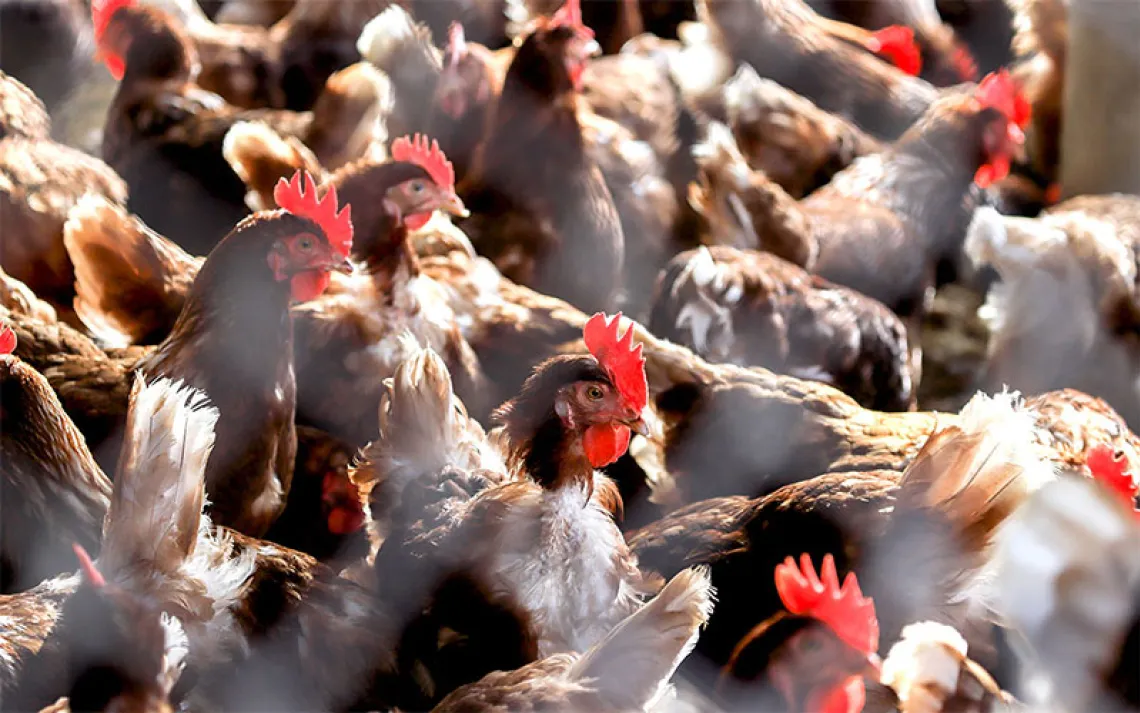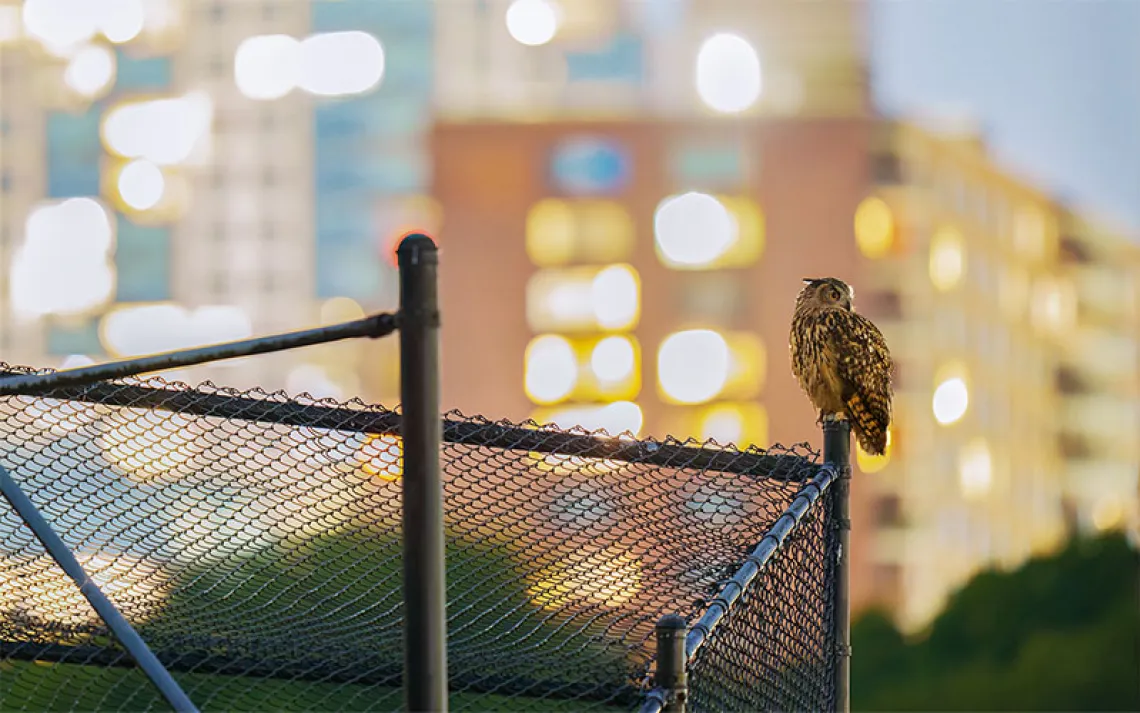Can California Condors Survive Avian Flu?
An outbreak among condors in the Southwest has wildlife conservationists on high alert

Photo by ablokhin/iStock
This story is jointly produced by Sierra and The Revelator.
In Arizona, fans of the endangered California condor frequently gather at the historic Navajo Bridge at Vermilion Cliffs, near where some of the very first condors were reintroduced to the wild, to watch breeding adults engage in their ritual courtship dances. The male stands in front of his mate, his dark, glossy wings spread, bald head bowed, circling her in a slow strut, rocking from one foot to the other.
Spring, when bonded pairs tend to their gawky, fluffy gray chicks, is a good time to celebrate the comeback of the Pleistocene-era vulture that very nearly went extinct before being returned to the wild in 1992. In late March, The Peregrine Fund, which manages the Arizona-Utah flock, announced that the first eggs of the 2023 season had been discovered. “We have quite a few other pairs we suspect are nesting but haven’t been able to confirm yet, so we expect the numbers to climb over the next few weeks,” condor program director Tim Hauck wrote in a Facebook post. “We had 13 confirmed nesting attempts in 2022, the highest number since the establishment of the AZ-UT population in the late 1990s, and we’re hoping to equal or even best that number this year.“
The celebration was cut short when staff noticed a condor—a nesting female—acting lethargic. On March 20, a field crew went and collected the bird, which had died below her nest. Meanwhile, other birds had sickened.
On April 7, US Fish and Wildlife Service announced that three condors from the Arizona-Utah flock were confirmed to have died of Highly Pathogenic Avian Influenza, or avian flu. The horror continued. US Fish and Wildlife set up an Incident Command Team to deal with the outbreak. By April 17, 20 condors had died—about 20 percent of the entire flock, which numbered 116 birds before the flu outbreak.
It’s impossible to say how the condors first contracted the deadly flu, says Joanna Gilkeson, public affairs officer for US Fish and Wildlife Service. The highly contagious virus can be transmitted from bird to bird, through feces, or by ingesting an infected animal.
To reduce the risk of lead poisoning, staff from The Peregrine Fund regularly supply uncontaminated carcasses to their flock. As soon as they suspected avian flu, they stopped providing the sociable condors with supplemental food and water. They hoped that by discouraging them from congregating, they could reduce the chance of transmission among the remaining birds.
The comeback of the California condor is often celebrated as one of the greatest success stories in wildlife conservation history. An episode like this highlights how fragile the species still is. “Even though we have more than 500 individuals in the world, we’re not out of the woods,” Hauck says.
The avian flu outbreak among condors highlights the worrying rise of this new threat among wild birds at a time when many species are already facing serious declines.
Low pathogenic avian influenza is widespread in both domesticated poultry and wild birds, especially geese and ducks. It usually doesn’t cause severe symptoms or disease. But the virus can mutate into a highly pathogenic strain.
This happened in North America in 2015, when 50 million domesticated birds, mostly chickens and turkeys, died or were culled. Though devastating to the livestock industry, wild birds were largely unaffected.
A newer subtype called H5N1 made landfall in North America in Newfoundland in December 2021. The first cases appeared among domestic fowl, then seabirds. Soon, outbreaks were being reported among wild birds all over Canada and the United States.
This outbreak is different, says Johanna Harvey, postdoctoral researcher at the University of Maryland who is leading an effort to track the spread of H5N1 in North America.
H5N1 is impacting wild birds more than it ever has, says Harvey. The disease is ravaging seabirds, shorebirds, and raptors. Tens of thousands of colony-forming seabirds have died, as have scores of Caspian terns, hundreds of bald eagles and countless birds that we don’t know about. Songbirds don't seem to be susceptible.
“Equally important is the diversity of wild species that are being impacted, including many sensitive species,” says Harvey. “And it’s happening at a time when wild birds are facing steep declines because of habitat loss, degradation, and climate change.”
H5N1 is also not fizzling out like previous subtypes have. “We’re seeing sustained disease throughout the year,” Harvey says. Because of this, birds are continuing to spread it around the globe as they migrate.
“This huge diversity of highly migratory species like gulls and skuas—and other birds that we know have expansive migration patterns—are moving the disease in ways we haven’t seen before,” she Harvey. H5N1 is expanding into Central and South America. “Antarctic populations may be next, which would be disastrous,” says Harvey.
Harvey and her fellow researchers are urging a coordinated management approach involving as many decision makers as possible to help respond to the crisis and its many unknowns. Their findings have been published in Conservation Biology.
If there’s any silver lining with this HPAI outbreak, it’s that the vast team of partners involved in condor conservation already coordinate closely with each other. Flock managers had been preparing for a potential outbreak for nearly a year, ever since it became clear that H5N1 was killing wild birds.
Ironically, the fact that California condors remain so endangered and isolated offers them some protection. When conservationists began re-establishing wild populations in the late 1990s, they deliberately created distinct flocks: in northern Arizona/southern Utah; Baja, Mexico; Southern California; and Central California; More recently, condors have been reintroduced in Northern California’s redwood country.
“These are five truly separate flocks,” says Kelly Sorenson, executive director at Ventana Wildlife Society, which co-manages the central California flock. “Except for rare instances of mixing between the southern and central California flocks, we’ve never documented movement among those sites.”
The geographic separation was by design, to ensure that if a disease or natural disaster were to strike one flock, it would likely not impact the others. Today, about 350 condors fly free, and there are over 200 birds in captivity. All of the flocks are supplemented with captive-bred birds, but condors are successfully reproducing in the wild, too. The biggest check on their overall population growth is lead poisoning, which accounts for half of all wild condor deaths and remains the bird’s greatest threat.
“The problem is, because bird flu is transmitted by wild birds, there’s really nowhere to hide. It’s scary in that regard,” Sorenson says.
Condors tend to hang out on ridges—high and dry places that aren’t friendly to viruses. But the sociable birds drop down to water sources—and on the coast, to beaches to feed on marine mammals, where they come into contact with shorebirds, which are known carriers of HPAI.
HPAI has been detected in California, but so far, no condors have contracted it. In addition to careful monitoring, managers of the central and northern California flocks have launched fundraisers so they can acquire or build quarantine pens. Ventana Wildlife Society raised $85,000 in a week, allowing the organization to order 10 pens, which in a worst-case scenario could contain up to 30 condors. If staffers detect a sick bird, they will immediately capture and isolate it. The mesh on the pens is fine enough to keep other birds from entering, and the design prevents other birds from roosting (and pooping) on top of the pens.

Sign up to receive Sierra News & Views
Get articles like this one sent directly to your inbox weekly.
With this action you affirm you want to receive Sierra Club communications and may vote on policy designated by the Sierra Club Board.
Because The Peregrine Fund uses radio telemetry and GPS to track individual condors, its staff has been able to locate and recover sick birds that are still alive and most of the dead birds that could potentially spread the disease. “I really truly think that because of the level of monitoring we’re doing, that we’ve limited the number of mortalities,” Hauck says. “As bad as it is, it could have been a lot worse.”
The live birds that crews retrieved in Arizona were severely dehydrated and malnourished. “They’re suffering from the flu; we all know what that’s like,” Hauck says. “Now think of a flu that’s worse than any flu you’ve ever had.”
Originally, eight condors were taken to Liberty Wildlife. Four soon died. Veterinarians are providing the four remaining birds with the avian equivalent of chicken soup: fluids, vitamin B complex, and a single shot of meloxicam, which reduces inflammation. The birds are improving and Hauck is cautiously optimistic that they will recover.
“HPAI is usually fatal in other species,” Hauck says. “This is new for condors, and what we’re seeing is it does look like some of the birds are able to get through it, which is very hopeful given the high mortality rates that have been documented in other species that contract this virus.”
Condors that recover will have natural immunity and shouldn’t contract the H5N1 strain again. They will also likely have some degree of immunity even to new mutations of the virus. In the near future, flock managers may be able to vaccinate condors against HPAI.
“USDA and US Fish and Wildlife are having conversations about trial runs for vaccines for condors, specifically,” Gilkeson says.
The Peregrine Fund is raising money to help pay for the extra travel, lodging and field time for its staff, and for transporting and treating sick birds. The response has been overwhelming, with donations from 48 states and several countries. Just as important has been the emotional support, especially for field staff reeling from the loss of 20 condors, including 11 adults that were actively tending eggs or young.
Some birds that could have been potentially been exposed to HPAI are still tending to their nests. “That’s a plus,” Hauck says. “The fact that we still have breeding birds that are seemingly uninterrupted is heartwarming for us.”
How you can help: official guidance from US Fish & Wildlife Service
If you see a condor exhibiting any of the following signs of illness in Arizona or Utah, please contact The Peregrine Fund at 928-352-8551 or condorprogram@peregrinefund.org. Signs include lethargy, incoordination, presenting as dull or unresponsive, holding head in an unusual position, and walking in circles.
Please follow these best practices to help limit the spread of the virus and avoid bird-human contact:
- Report dead or sick animals to your state wildlife agency.
- Keep your family, including pets, a safe distance away from wildlife.
- Do not feed, handle or approach sick or dead animals or their droppings.
- Always wash your hands after working or playing outside.
- Prevent contact of domestic or captive birds with wild birds.
- Leave young animals alone. Often, the parent animals are close by and will return for their young. For guidance on orphaned or injured wild birds, please contact your nearest wildlife rehabilitation center, state wildlife agency, or local land management agency.
- USDA also has biosecurity guidance for people who keep backyard poultry.
 The Magazine of The Sierra Club
The Magazine of The Sierra Club



